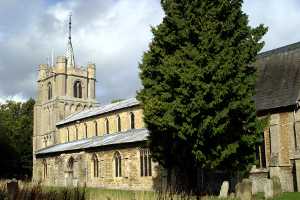Elm, Cambridgeshire
| Elm | |
 All Saints Church, Elm |
|
 Elm |
|
| Population | 3,295 |
|---|---|
| OS grid reference | TF477062 |
| District | Fenland |
| Shire county | Cambridgeshire |
| Region | East |
| Country | England |
| Sovereign state | United Kingdom |
| Post town | Wisbech |
| Postcode district | PE14 |
| Dialling code | 01945 |
| Police | Cambridgeshire |
| Fire | Cambridgeshire |
| Ambulance | East of England |
| EU Parliament | East of England |
| UK Parliament | North East Cambridgeshire |
|
|
Coordinates: 52°38′N 0°11′E / 52.63°N 0.18°E
Elm is a Fenland village in Cambridgeshire, England. The civil parish of Elm had a resident population of 3,295, as recorded during the 2001 United Kingdom census. It is located alongside the county boundary with Norfolk, on the outskirts of the market town of Wisbech. The northern end of Elm, alongside Elm Low Road, acts as an adjacent suburb of Wisbech. Elm is situated in the heart of The Fens.
Elm
Situated in the Fens, much of the parish would have been undrained salt marsh and salt lagoon, with any higher areas, such as that around Wisbech, forming fen-islands. Mesolithic hunter-gatherers would have fished and hunted waterfowl from these islands. Later, farmers would have grazed their sheep and other livestock on the rich marsh pastures. The area was also occupied during the Roman period, with domestic finds scattered through the parish, concentrating along the Leam stream that may have been canalised during the Roman period. Asides from agriculture, there is archaeological evidence of salt processing in the Elm area.
Drainage and falling sea levels may have prompted the settlement of Elm by the Medieval period. In the 13th Century the parish was prosperous enough to fund the building of a significantly extravagant church. However, the lower laying parts of the parish were probably not fully drained and reclaimed until as recently as between the 17th and 19th Centuries. Later satellite settlements formed to the south of the parish at Friday Bridge and at Coldham, alongside the Leam, where land was better drained.

Elm, or Elme, once had a stop on the Wisbech and Upwell Tramway, known as Elmbridge as it was located just over the border in Norfolk near to a bridge that spanned the former Wisbech Canal. This canal connected the River Nene at Wisbech, to a junction with the Well Creek and the Old River Nene at Outwell, and passed along the northern edge of Elm.
The canal was abandoned, and finally filled in during the 1970s. Parts of it have been converted into a public green lane that starts at the post office, and terminates at the site of Collets Bridge. The tramway that ran alongside the canal was in turn closed to passengers from 1927, and finally discontinued as a freight line in 1966. It also has since been dismantled.
Besides allotments and market-gardening, a number of apple, pear, and plum orchards have been planted on the better drained soils close to the village centre in the north of the parish, while the lower laying peat soils further out, are cultivated as high grade arable land. The orchards (some of which have since been replaced by new housing developments) used to attract fruit pickers from London on working holidays. After World War II, many of these seasonal visitors would stay at a disused POW camp at Friday Bridge. The camp today is used mainly by seasonal agricultural workers from abroad.

A stream, known as The Leam, once flowed from March to Wisbech, past the church, and through the village. This stream has now been drained away, and only survives today as a pond to the south of Elm, at Friday Bridge.
The parish church is a large pin spired, stone building, mainly of Early English 13th-century origin, and is dedicated to All Saints. Other notable local buildings include the Grade II listed Elm House, that has been dated to 1630, and the Sportsman public house, dated to the late 17th Century.
Local services
Although situated close to the market town of Wisbech, Elm is locally served by a primary school, a post office, local shop, hairdressers, garages, and three public houses. A bus service stops in Elm, running between Wisbech and March. The nearest railway station is at March. National Cycle Network 63 from Wisbech to Burton on Trent, passes directly through the village.
Notable residents
Pioneering agricultural engineer Thomas Aveling was born in Elm on 11 September 1824. He was the co-founder of Aveling and Porter, the largest British manufacturer of steam rollers and other steam-powered vehicles.[1]
References
- ↑ "Thomas Aveling". Oxford Dictionary of National Biography (online ed.). Oxford University Press. doi:10.1093/ref:odnb/38436. (Subscription or UK public library membership required.)
External links
| Wikimedia Commons has media related to Elm, Cambridgeshire. |